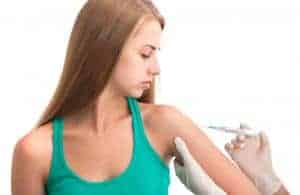The number of teens ages 13 to 17 receiving the human papillomavirus (HPV) vaccine remains disappointingly low, despite high coverage for two other vaccines regularly recommended for adolescents, the US Centers for Disease Control and Prevention (CDC) said today.
An in-depth analysis of HPV vaccination patterns in recent years, however, revealed promising strategies for boosting levels, such as health providers routinely giving it alongside two other vaccines. That study and one on uptake of HPV and two other adolescent vaccines appeared today in Morbidity and Mortality Weekly Report (MMWR).
At a media briefing today, Anne Schuchat, MD, director of the CDC’s National Center for Immunization and Respiratory Diseases, said a telephone survey showing only a tiny rise in HPV vaccination level doesn’t make for eye-grabbing headlines. “We don’t have big news, but no news is bad news for cancer prevention,” she said.
The other study looked at HPV vaccine uptake for 2013, alongside two other recommended vaccines for adolescents: the tetanus, diphtheria, and acellular pertussis (Tdap) and the meningococcal conjugate (MenACWY). Both studies were based on National Immunization Survey-Teen (NIS-Teen) data.
HPV is the most common sexually transmitted infection, and most people who have it don’t know they are infected. The virus has been linked to several cancers, including cervical. For the best protection against future disease, the CDC recommends that girls and boys be vaccinated starting at age 11 or 12, so they can develop immunity before they are sexually active.
Phone survey shows only slight rise
The phone survey, which used random-digit sampling, has been collecting information on adolescent vaccination since 2006. It started including cell phone numbers in 2011. For 2013, the survey included data for 18,000 adolescents.
Researchers found a large gap between HPV uptake, which lags far behind that for Tdap and the meningococcal vaccine, and the CDC called the latest HPV findings “unacceptably low.”
The investigators estimated that for 2013, 57% of girls and 35% of boys had received one of three doses of HPV vaccine. For comparison, the second MMWR study showed that nearly 86% received one Tdap dose.
From 2012 to 2013, coverage increased for all three of the vaccines. Receipt of one or more HPV dose rose by 3.5 percentage points, to 57.3%, for girls and rose by 13.8 percentage points, to 34.6%, for boys.
Over the same period, coverage rose to 86% for the Tdap vaccine (from 84.6%) and to 77.8% for the meningococcal vaccine (from 74%). The national target for the vaccines is 80%.
Missed opportunities
Schuchat said the coverage gaps reveal missed opportunities to vaccinate boys and girls with HPV vaccine at the same time routine Tdap and meningococcal vaccines are given.”The high coverage rate of Tdap vaccine shows us that it is certainly possible to reach our goal of vaccinating 80% of adolescents against cancers caused by HPV,” she said.
The CDC estimates that if missed opportunities to vaccinate girls before their 13th birthday were eliminated, 91% of them would have some protection from HPV-related cancers.
“Pediatricians and family physicians are uniquely situated to prevent missed opportunities by giving HPV vaccine during the same visit they give Tdap and meningococcal vaccines,” Schuchat said.
Study findings also showed that a doctor’s recommendation influenced whether parents had their daughters or sons vaccinated against HPV. For parents of girls who were vaccinated, 74% had received a physician’s recommendation, compared with 52% who did not seek immunization. For boys, the doctor’s recommendation had an even stronger impact, with 72% of those vaccinated having received a recommendation, compared with 26% among those who were not immunized.
Schuchat said survey data show that five states have had impressive rises in HPV coverage: Illinois, Michigan, New Hampshire, New Mexico, and South Carolina. Though states varied in their strategies for boosting HPV vaccination levels, lessons can be learned from their successes, Schuchat said.
For example, some worked closely with their state American Academy of Pediatrics (AAP) or American Academy of Family Practice (AAFP) chapters, while others provided ongoing coverage feedback to physicians or used peer-to-peer office visits. She added that cancer organizations helped with HPV vaccination efforts in South Carolina.
Good safety data
The study that provided a more detailed look at HPV vaccine coverage from the phone survey also looked at safety data. Researchers reported that no serious safety concerns have been found in 8 years of postlicensure vaccine safety monitoring and after 67 million doses of vaccine administered.
Today’s report said the most common symptoms following vaccination are injection-site pain, redness, and swelling. Other common ones include dizziness, fainting, nausea, and headache, according to the report.
Parents are starting to think about steps they need to take to get kids ready to start a new school year, and making sure adolescents are up to date with the three vaccinations should be on their lists, Schuchat said.


